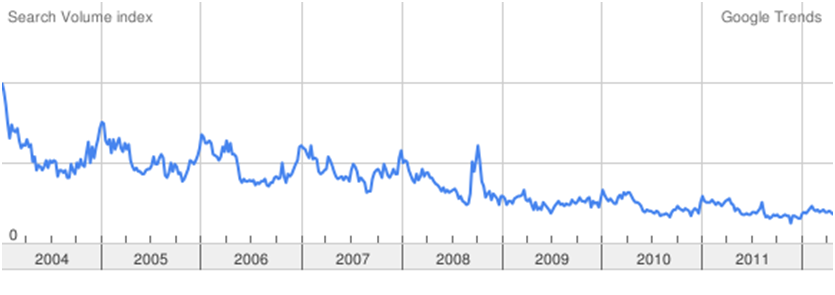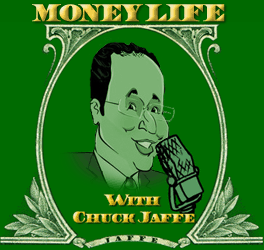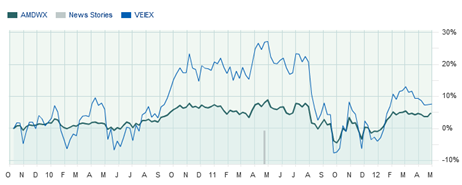There was a time not so long ago when retirement was something that most Americans took for granted. You worked for a company till you were 65, then you retired and collected a pension that allowed you to live comfortably. Since the 1990’s however, legislation and the changing economic landscape have meant that the number of people covered by pensions has drastically reduced. With Social Security effectively in a state of permanent deficit, the old notion of flying into your golden years on auto-pilot had vanished for most of us. By the end of 2004 a majority of individuals had turned to a bewildering array of different contributory programs (401k, 403b, 457, IRAs, Roth, SEP, SIMPLE, Keogh) and personal investments as their primary retirement plan. While the affluent and the less-so vary in the extent of their retirement resources, it’s increasingly the case that we’re all in the same boat: we’re all being asked to make on our own the decisions which will shape the decades we spend in retirement.
Joining us this month to assist with “The Best of” feature, is our guest expert, Johanna Fox Turner, Certified Financial Planner, owner of Milestones Financial Planning, LLC, and author of a monthly financial tips newsletter, which to our delight includes Johanna’s (Almost) Famous Recipes. Johanna joined me in researching each of our alternatives and provided insightful comments based on her years of expertise. Thank you, Johanna.
Johanna Fox Turner has been a CPA for over 30 years and a Certified Financial Planner since 2007. She is a graduate of David Lipscomb University and a Registered Life Planner.
Johanna is a Fee-Only™ financial planner/investment manager and in addition to Milestones is the owner of Fox & Co, CPAs in Mayfield, Kentucky. She has served as president of the Mayfield-Graves County Chamber of Commerce, trustee at Mid-Continent University, city of Mayfield councilwoman, and as chairman of the Graves County Republican Party. She is the monthly financial columnist for Paducah Sun’s Four Rivers Business Journal and teaches continuing education classes in financial planning and investing for electricians and contractors.
In this month’s “Best Of” feature we’re taking a look at retirement calculators, those little widgets we find on almost every financial website. Having a reliable estimate is critical to adjusting both our expectations and our current efforts. Retirement calculators are predictive tools; some offer simple extrapolations while others undertake complex Monte Carlo analyses in which they simulate hundreds of possible markets. Simple tools tend to produce a single number (“you’ll have $427,218.27”) while more complex ones offer a range of possible outcomes and probabilities for each (“you have a 10% chance of having $600,000 or more, a 50% chance of …”). Regardless, none offer guarantees.
The question is: who offers a reliable estimate for you?
So how did we choose this month’s “Best of” Retirement Planners?
- We createdan imaginary investor, Robin.
- Age 50
- Income: $50 000/year
- 401(k) balance of $100,000.
- Retirement age 70 (20 years from now) and with end of plan (death) in 20
- Total annual contribution (employer + employee) of $7000.
We used the same inputs for projected inflation, rates of return, asset allocation and post-retirement income needs (not all sites requested all of that info).
- We identifieda dozen popular web-based retirement income calculators.
- We searched the phrase “retirement income calculator” reviewing the first 50 sites.
- We eliminated those requiring registration and those that were duplicated from one site to the next.
- We limited ourselves calculators to major retirement plan providers, financial news and information sites, and independent organizations (such as AARP or FINRA).
- We graded each calculator on three criteria:
- Ease of use and comprehension
- 20 minute time limit to get results. Apart from basic personal and financial information we required the following inputs:
- Inflation rate
- Social security benefits
- Investment allocation and/or simulation of multiple market scenarios
- Quality of output and ability to adjust variables. In particular we looked for:
- Results presented in simple terms, either in monthly or annual income
- The probability of success (or failure), rather than a “magic number”
- Recommendations to reach your desired goal
We came up with eight finalists. Of these, two met all our requirements while a third fell just short. To emphasize the need to consult a financial professional and not rely solely on retirement income calculators for your retirement planning, we have included a professional report on Robin’s retirement prospects that was prepared by Johanna. Things may not be as rosy for Robin as some of the calculators predict…
T Rowe Price – Retirement Income Calculator
Their Premise
T Rowe Price promises a quick and simple process that should be completed in 10 minutes or less and claims to get us there in three easy steps!
Our Evaluation
The Calulator
https://www3.troweprice.com/ric/ricweb/public/ric.do
The Process
T Rowe Price uses a multi-page approach with little touches of animation. This was one of only two calculators that met all of our input requirements. The “tell us about you” section is pretty straightforward. You begin by entering your basic information and then your status (saving, preparing for or living in retirement).
Ease of Use
This software is easy to use and the pages really fly by. Convenient worksheets are provided to aid you with your calculations should you need them and inflation is automatically calculated. I found the experience simple, pleasant, and straightforward.
Input and time required
Speed-wise, they live up to their promise. The financial evaluation section is pretty straightforward. You begin by entering basic financial information, and then go on to simple asset allocation choices where you can choose a TRP model portfolio or adjust sliders to a mix of investments. (Our investor chose 70% stocks and 30% bonds as his current allocation and 35% stocks, 35% bonds and 30% short term for retirement.)
Finally, you enter your proposed retirement age and other income (such as Social Security, which the system can project).
Quality of Output
You’ll get a couple of compact summaries that include a probability of your money lasting until the age of 95. The first estimates your monthly income, assuming 75% of pre-retirement income. The second scenario projects the total amount that they estimate you will be earning monthly based upon your data entry.
For example, TRP concludes Robin will need $3125.00 a month during retirement while he is set to make $3414.00 from Social Security and his retirement account. If he spends 75% of his previous income there is an 83% chance that his money will last. If he chooses to spend it all, the Monte Carlo results drop to the suggested minimum of 70%.
You have the opportunity to adjust your inputs and compare the results of your adjustments against your current results. On the suggestions page, you’ll see a final wrap up and recommendations that can help you achieve your goals.
Bottom Line
Pros: Easy to use and easy to understand. Solid set of inputs and a quick turnover time. Good output quality and free tools from Morningstar
Cons: Some settings (pre-retirement income percentage and length of retirement) are fixed.
Johanna’s comments: I liked the simplicity of input and the last screen offering options to adjust various numbers was pretty slick. The TRP tool is fairly robust and I must say that the upside to registering is that you can save your information. The interactive presentation at the end is nice if you don’t leave the site too quickly (which I did the first time I ran through the numbers). A problem I have with the presentation, though, is that in offering the choice of allocations, risk is not explained. Users may naturally be drawn to the 100% equity allocation without understanding the impact of volatility, even though the program makes recommendations). Surprisingly again, no inflation numbers that I can find.
CNN Money – Retirement Income Calculator
Their Premise
CNN Money promises to help you evaluate how well your savings program is preparing you for retirement. They also tell you your chances of getting there and offer suggestions if you are falling short.
Our Evaluation
The Calculator
http://cgi.money.cnn.com/tools/retirementplanner/retirementplanner.jsp
The Process
CNN Money eschews style for substance choosing a simple, static, tabbed layout. The presentation is simple and the operation straightforward. Enter info, click next.
Ease of Use
Things move along at a quick pace and you are never stuck on a tab for very long. Social security and inflation are also calculated for you. The language is simple to understand and process is as easy as Sunday morning.
Input and time required
All our input requirements were met (although rate of return was dealt with in their output) and the process was over in less than 10 minutes. The calculator is divided into five tabs, four of these are dedicated to input; goals, income, savings and portfolio. Under “Goals” you enter your age, your desired retirement age, your life expectancy, as well as what you currently earn and desired retirement income. Under “Income” you enter your desired retirement age and any expected sources of retirement income including expected pensions and social security (the number is calculated for you). The “Savings” tab lets you enter your current total retirement savings and the total (employer + employee) annual contribution to your retirement. You can also add information about taxable accounts and taxes. Under “Portfolio” you can choose one of seven allocation options, from very conservative to very aggressive. Our investor chose an aggressive portfolio, 70% stock (10% non US) and 30% bonds (5% treasury bills)
Quality of Output
The “Results” tab summarizes using simple and plain language and wastes no time beating around the bush. The tab is broken into two main segments. YOUR NEEDS briefly outlines how much money you will require annually (with adjustments for inflation), and how big a nest egg you need to achieve your goal. Your CHANCES OF GETTING THERE tells you at what rate your investments need to grow in order to achieve your target. It also estimates the probability that your investments will grow by the required rate. CNN Money (unlike T Rowe Price) gives no explanation of how they came up with these results, though. Below the brief summary, a bar chart displays the probability of four different retirement scenarios. You are given options to view your annual cash flow and to tweak your results.
Bottom Line
Pros: Fast and easy to use. Simple and straightforward. Good range of inputs. Gives a range of possible scenarios and the probability of each.
Cons: No explanation of their methodology. How they decide what chance your investments have of growing by a particular rate is not clear. While they give you the probability of reaching your initial savings target, they don’t estimate the chances of your money lasting throughout your retirement.
CNN Money estimates that there is a 99% chance that our investor’s portfolio will grow at the rate required to achieve his retirement savings goal.
Johanna’s comments: The calculator was not especially easy to find from the home page – I would have preferred to have a “Tools” link that took me to the calculator instead of reading and guessing what I needed from a list of questions. These two were the only programs I looked at, however, that let the user choose between portfolio allocations (rather than inputting a desired rate of return) and I liked that feature. I was left to assume that the planner uses Monte Carlo simulations to get to the predicted chance that Robin will reach his goal. I like the cash flow page, which allows skeptical me to do a couple of quick checks on their numbers!
The Rest
MSN Money gets an honorable mention. They take the “less is more” route but ultimately it’s just a bit too lightweight; offering a quick and dirty one page retirement calculator that is useful as a fast reference but little more.
You can find the other five finalists here:
|
Website |
Easy to locate |
Ease of Use |
Flexibility |
Clarity of Results |
My Rating |
Johanna’s Comments |
| AARP | YES | YES | YES | SO-SO | 2 | Like the graph for projected savings. However, it appears that this tool drastically underestimates what Robin will need to have saved for retirement. |
| Bloomberg | YES | YES | YES | MIXED | 5 | No consideration for inflation; no guidance on how much you’ll need at retirement. They must have changed the tool but not the directions because they refer to withdrawals but there is no input for them. |
| Fidelity | YES | YES | YES | 3 | Except for The Voice, this is a nice little tool that is quite adequate for a quick check-up | |
| Kiplinger | YES | YES | NO | YES | 4 | Helpful home equity section. Problem: asks you to estimate both average return and % of in equities, even though these figures are highly correlated. |
| Merrill/BOA | YES | YES | NO | YES | 3 | Same comments as Fidelity. A little more info than Fido but not happy with the portfolio choices. |
| TIAA-CREF | NO | YES | YES | NO | n/a | This is a school-employee site. If you’re not one, go elsewhere. If you are, this is for you as it focuses on the unique plans of school employees |
| Vanguard |
NO |
YES |
YES |
YES |
1 |
My favorite of all, but I had to Google to find the link as it was MIA from the home page. Does not calculate account balance at retirement. |
The chart above can be downloaded as a .pdf file, as well.
As always we realize that our picks may have left out a candidate that turns out to be superior. Please contact me if you have a website or calculator that you believe we should add. We always look forward to your feedback.
[cr2012]








